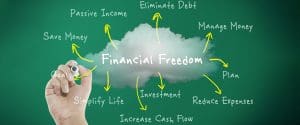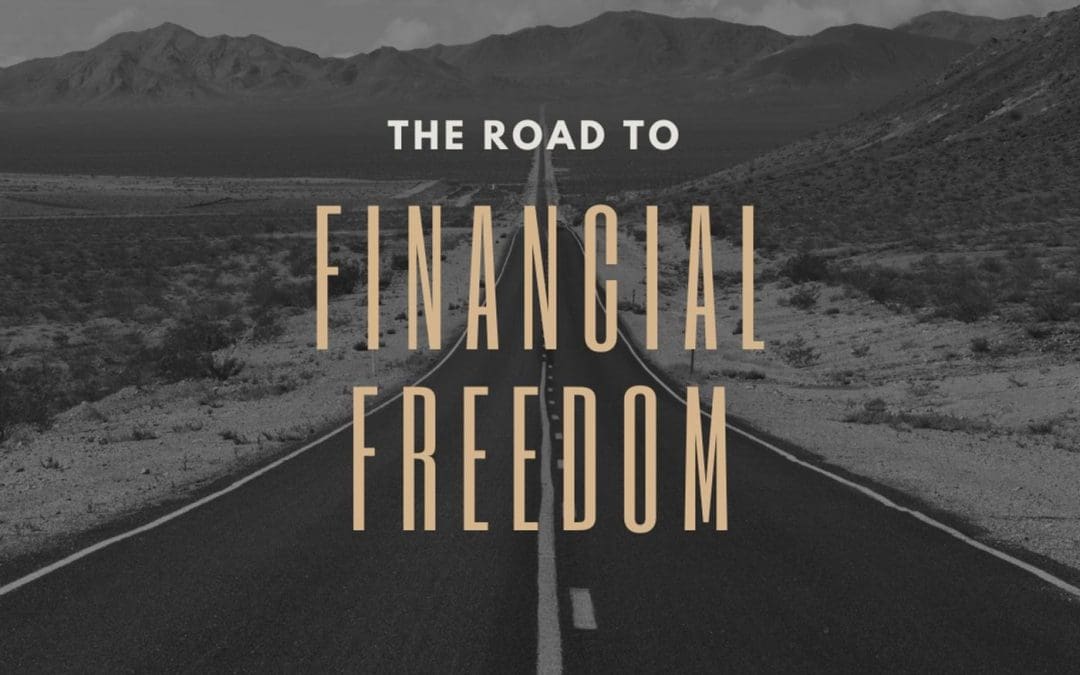 There are many ways to reach financial freedom, or some definition of financial security or success, and while this blog is by no means the definitive path to reaching that, hopefully it can help guide you to reach this goal, no matter where you are in your current course.
There are many ways to reach financial freedom, or some definition of financial security or success, and while this blog is by no means the definitive path to reaching that, hopefully it can help guide you to reach this goal, no matter where you are in your current course.
I am going to provide two examples, the first as someone just entering the workforce and the other, as someone trying to get out of debt and further along in life. Even if neither of these scenarios fit your life perfectly, try to figure out where along the steps you are, and jump in there.
Entering the work force (unmarried and no kids):
Step 1: Budget & Save – Budget your income and save 20% (SAVE, not invest), ideally in a properly designed WL policy, but at least in a high yield savings account or money market. So, say your first job paid you $48,000 a year, or $4,000 per month, you would save $800 a month, and the $3,200 left over is your budget for everything else. I would also, personally, avoid contributing to a 401k at this point. Redirecting that illiquid money into liquid savings is far more important at this juncture. Read books and listen to podcasts on investing in real estate, private lending, dividend stocks, and other investment vehicles.
Why? – What we want to do in this first step is start the habit of paying yourself first, living below your income, and begin the process of building an emergency fund.
 Step 2: 6 Months of Expenses – Continue to save that 20% until you have saved 6 months expenses (~$19,200). As you receive raises, put half of the raise towards your savings. At this rate it should take just under 2 years to get to this goal. Continue to read books and listen to podcasts on investing in real estate, private lending, dividend investing, and other investment vehicles.
Step 2: 6 Months of Expenses – Continue to save that 20% until you have saved 6 months expenses (~$19,200). As you receive raises, put half of the raise towards your savings. At this rate it should take just under 2 years to get to this goal. Continue to read books and listen to podcasts on investing in real estate, private lending, dividend investing, and other investment vehicles.
Why? – We want to continue to build good habits, like paying yourself first, even as your income begins to increase. And we want to shoot for 6 months in a liquid emergency fund so that if you lose your job, or have some sort of big emergency (or big opportunity) arise, you have the capital accessible to deal with the hard time, or take advantage of the opportunity. If you had spent this income, or put it in an investment that was illiquid, you will regret it (and may have to take out high interest debt to solve the problem, compounding your problems).
Step 3: Give yourself an Experience and Re-evaluate – Go on a trip or do something fun and adventurous. Maybe quit your job, take some portion of your savings, and go to SE Asia for two months, or do a European backpacking trip. You are young, have limited responsibilities, and now is the time to have these sorts of experiences. You have savings after all! This is also a good time to decide if the career path you originally decided on is for you or not. If not, make a career change. You can do these things because you have the savings (if it were in a 401k, you would not have this luxury). Continue to read books and listen to podcasts on investing in real estate, private lending, dividend investing, and other investment opportunities, especially while you’re backpacking through Europe or Asia, you’ve got plenty of time so use it to grow your knowledge base.
Alternatively, if this experience option isn’t your thing, perhaps instead try to start that business you have been dreaming of. Or take that 100% commission sales job you’ve wanted to try. Or take the plunge into some other industry you have been interested in.
Why? – Because you are only young once, and once you have bigger responsibilities you won’t have the time or luxury to create these memories or start that business/take that sales job. Plus, at this age you are more likely to be comfortable in more rustic, inexpensive living conditions, so you can do these trips much cheaper. Once you’re older you will be far less likely to want to stay in a bunk-bed in some hostel with 5 other strangers in your room. Do it now while you are low needs and can travel/live for cheap.
Step 4: 6 Months of Expenses – If you spent down your savings in step 3, save that 20%, plus half of your raises, until you are back to 6 months of expenses. Continue to read books and listen to podcasts on investing in real estate, private lending, dividend investing, and other investment vehicles.
Why? – We need to build that safety net back up for ourselves.
Step 5: Opportunity Fund & Planning to Invest – Once you have hit the 6 months of savings, continue to save, but now anything above that number is your “opportunity fund”. This is when you can start to put into practice the things you’ve learned reading all those books and listening to all those podcasts. When thinking of this opportunity fund, you will want to create a breakdown of your ideal asset allocation for these dollars. So, for example, it might be something like 50% in Real Estate (of that, 50% short term rentals and 50% multi-family etc.), 20% private lending, 15% crypto, 10% Stock market, 5% gold. This should be diversified, and focused mainly on real assets that produce cash flow, rather than speculative assets like most stocks or crypto.
Why? – At this point, with 6 months in an emergency fund, we have enough of a security blanket that we can begin to take on more risk with the dollars we were saving. We want to focus on assets that cash flow (like real estate, dividend stocks, private lending, land investing etc.) because our focus should be on having said cash flow eventually replace our expenses. Once we achieve this, we are financially free. So, we want to work towards that.
Step 6: Invest and Build your Asset Allocation – Start building towards this asset allocation. This may take weeks, months, or even years. But build towards it and rebalance as needed.
Why? – Building your asset allocation is generally not something that you can do overnight, especially if most of it will be in non-traditional assets, or in Real Estate. So have patience here. Create your ideal asset allocation and then begin building up to it. What we don’t necessarily want is to over invest in one asset class.
Step 7: Back to Saving: 1 or 2 years of expenses – At some point you will start to add responsibilities to your plate, maybe you get married, have children, a sick parent, a mortgage, a volatile job or business, etc. Or you may have a large Real Estate portfolio, or you have too much in risky speculative assets. At this point, you need to refocus on saving and less on your “opportunity fund”. So now we want to make sure we have between 1 to 2 years’ worth of expenses in our liquid savings account (ideally this savings should be in a properly designed WL policy at this point, if it isn’t already—and really, it should have been from the start). If you are a business owner, or in a commission job, or have kids, and a mortgage, you may want to lean more towards 2 years of expenses, whereas if you are W-2, married but no kids, you can lean towards the 1 year. But note that I have seen too many highly educated and experienced people go 2+ years without a job, so don’t think 2 years is the max you might need to have in liquid savings.
Why? – 6 months of expenses isn’t going to cut it for most people when they lose a job, or some other major emergency occurs. So, as we are adding responsibilities to our plate, and as our need for stability increases, we need to also increase our emergency fund. You can do this either by simply cutting off the opportunity spigot completely until you hit the 1 or 2 years in your emergency fund or split the 20%+ of your income you are investing and save some portion of it, while simply reducing your opportunity fund in tandem.
Step 8: Back to Investing with a Focus on Cash Flow – Once you have saved the 1 or 2 years of expenses, then begin refocusing on building out your investment asset allocations. Continue to focus more on generating cash flow with your investments, rather than focusing on asset appreciation or accumulation. We want to begin pushing to get closer to having the income from our investments cover our personal expenses, so that we achieve financial freedom (not having to work for a living and regain your time freedom). This will not only give you more flexibility in your career and working decisions but will ensure a retirement with less anxiety and risk.
Why? – At this point we should have a laser focus of trying to increase our cash flow from investments so we can eventually have the freedom to live our life without financial anxiety or without finances controlling all our decisions. This occurs when our investment cash flow is greater than our monthly expenses.
Step 9: Achieve financial freedom! – Your cash flow from your investments is equal to your living expenses. At this point you are free and could choose to leave your W-2, or not. You are no longer beholden to anyone but your own desires. If you do quit your W-2 make sure you replace it with some other passion/purpose. Enjoy your new life!

Already in the work force (has debt, no savings, and a family):
Step 1: Budget & Save 1 Month of Expenses – You have debt, but you also have no savings, so to start, go over your budget and cut unneeded expenses until you get to a point where your NET income is 10-20% of your income. Redirect that 10-20% into a liquid account like a high yield savings account until you get to 1 month of expenses. Continue to pay the minimum payment on the debt. Read books and listen to podcasts on budgeting, investing in real estate, private lending, dividend stocks, and other investment vehicles.
Why? – In this state of things, we have no ability to deal with even minor emergencies. So, the priority should be to cut back wherever you possibly can—if it isn’t going to put a roof over your head, food in your mouth, or any other necessity like that, you need to cut it, at least temporarily—and then save the difference so you can get some breathing room.
Step 2: Pay Off Debt – Once you have the one month of savings, now redirect that 10-20% to your debt (not counting your mortgage, only pay the minimum on that). There are various methods you can choose when it comes to which debt to pay down first, so that will be up to you, but you should either look to pay off the highest interest debt, or the lowest balance debt, or the highest monthly payment debt first. Direct that 10-20% of your income to just ONE debt instrument at a time. Once that first debt is paid off, then direct the 10-20% PLUS the monthly minimum payment from the now paid off debt to the second debt instrument and repeat until all debt is paid off. Read books and listen to podcasts on budgeting, investing in real estate, private lending, dividend stocks, and other investment vehicles.
Why? – Debt is like a massive weight on your shoulders, and if it’s too heavy it’ll prevent you from getting ahead at all. The interest on your debt is preventing you from making progress, and must be dealt with as quickly as possible. Most people see 30% of their spending come from debt financing, so if we can reduce this to Zero, we will be able to free up a significant amount of cash flow to redirect to savings, investments, or even lifestyle. The key is to pay off one debt instrument at a time and redirect those payments to the next debt instrument.
 Step 3: Consider Your Insurance – You have a family, make sure you have all your basic insurance needs. Purchase your ‘Human Life Value’ or at least your basic ‘Needs coverage’ in Term Life Insurance. If you are young and healthy this will be cheap. Make sure it is convertible and with a top-rated Mutual company (like Penn Mutual, Mass Mutual, Northwestern Mutual etc.). Look at supplemental Disability coverage, an umbrella policy, etc. Ideally you would begin doing this—if you hadn’t already—after you’ve paid off some of your debt and have freed up some cash flow that can pay for this coverage.
Step 3: Consider Your Insurance – You have a family, make sure you have all your basic insurance needs. Purchase your ‘Human Life Value’ or at least your basic ‘Needs coverage’ in Term Life Insurance. If you are young and healthy this will be cheap. Make sure it is convertible and with a top-rated Mutual company (like Penn Mutual, Mass Mutual, Northwestern Mutual etc.). Look at supplemental Disability coverage, an umbrella policy, etc. Ideally you would begin doing this—if you hadn’t already—after you’ve paid off some of your debt and have freed up some cash flow that can pay for this coverage.
Why? – Insurance is an important part of any household’s financial plan. Paying for it is rarely fun, but the protection you receive is almost always worth it, even for just peace of mind. But protecting some or all your assets—like the potential income you will earn in your life, your assets from lawsuits, or even a long-term care event—is a vital element in ensuring your financial future.
Step 4: Save 6 Months of Expenses – Now that your debt is paid off, and you have taken care of your insurance needs, it’s time to redirect all NET income to building up your emergency fund from 1 month to 6 months. At this point you should be saving between 10-30% of your income, ideally closer to 30%. This should be redirected into a safe and liquid account (preferably a properly designed high cash value whole life policy with a top-rated Mutual Insurance company, allowing you to accomplish numerous benefits for the same dollars saved). Continue to read books and listen to podcasts on investing in real estate, private lending, dividend investing, and other investment vehicles.
Why? – Up to this point we have mainly been trying to dig ourselves out of the debt trap, but now that we are above water, it is time to build some safety into our life so we can then take the next step without stress. Ideally, we have cut our budget to the most important needs, and since we have paid off all our debt (besides our mortgage, if we had one), most or all of those former debt payments and previous cash flow, should now be directed into savings. The reason the Whole Life is recommended for this purpose is for the many other benefits you get at the same time you are saving (Death Benefit, Tax deferred growth—tax free if done properly—asset protection, Long Term Care Insurance rider, Critical Care rider, uninterrupted compound growth, higher IRR of the cash value over medium to long term than in most liquid savings options, and many other benefits). We want our dollars to be doing multiple things for us at the same time if possible.
Step 5: Opportunity Fund & Planning to Invest – Once you have hit the 6 months of savings, continue to save, but now anything above that number is your “opportunity fund”. This is when you can start to put into practice the things you’ve learned reading all those books and listening to all those podcasts. When thinking of this opportunity fund, you will want to create a breakdown of your ideal asset allocation for these dollars. So, for example, it might be something like 50% in Real Estate (of that, 50% short term rentals and 50% multi-family etc.), 20% private lending, 15% crypto, 10% Stock market, 5% gold. This should be diversified, and focused mainly on real assets that produce cash flow, rather than speculative assets like most stocks or crypto.
Why? – At this point, with 6 months in an emergency fund, we have enough of a security blanket that we can begin to take on more risk with the dollars we were saving. We want to focus on assets that cash flow (like real estate, dividend stocks, private lending, land investing etc.) because our focus should be on having said cash flow eventually replace our expenses. Once we achieve this, we are financially free. Work towards that.
Step 6: Invest and Build your Asset Allocation – Start building this asset allocation. This may take weeks, months, or even years. But build towards it and rebalance as needed.
Why? – Building your asset allocation is generally not something that you can do overnight, especially if most of it will be in non-traditional assets, or in Real Estate. So have patience here. Create your ideal asset allocation and then begin building up to it. What we don’t necessarily want is to over invest in one asset class.
 Step 7: Save: 1 or 2 years of expenses – At this phase of your life, where you have many responsibilities, a spouse and children that rely on you, a mortgage, and may be adding larger responsibilities like a sick parent, a fast approaching retirement, or you have other responsibilities or large risks like a volatile job or business, a large leveraged Real Estate portfolio, or you have too much in risky speculative assets (hopefully not if you followed the advice here), you need to focus on building up your emergency funds. So, at this point, you need to refocus on saving and less on your “opportunity fund”. We want to make sure we have between 1 to 2 years’ worth of expenses in our liquid savings account (i.e. our Whole Life policy). Depending on your personal situation, you may lean towards the lower end or higher end. For example, if you are a business owner, or in a commission job, or have kids, and a large mortgage, you may want to lean more towards 2 years of expenses, whereas if you are W-2, have a small mortgage, kids are out of the house etc., you can lean towards the 1 year. But note that I have seen too many highly educated and experienced people go 2+ years without a job, so don’t think 2 years is the max you might need to have in liquid savings.
Step 7: Save: 1 or 2 years of expenses – At this phase of your life, where you have many responsibilities, a spouse and children that rely on you, a mortgage, and may be adding larger responsibilities like a sick parent, a fast approaching retirement, or you have other responsibilities or large risks like a volatile job or business, a large leveraged Real Estate portfolio, or you have too much in risky speculative assets (hopefully not if you followed the advice here), you need to focus on building up your emergency funds. So, at this point, you need to refocus on saving and less on your “opportunity fund”. We want to make sure we have between 1 to 2 years’ worth of expenses in our liquid savings account (i.e. our Whole Life policy). Depending on your personal situation, you may lean towards the lower end or higher end. For example, if you are a business owner, or in a commission job, or have kids, and a large mortgage, you may want to lean more towards 2 years of expenses, whereas if you are W-2, have a small mortgage, kids are out of the house etc., you can lean towards the 1 year. But note that I have seen too many highly educated and experienced people go 2+ years without a job, so don’t think 2 years is the max you might need to have in liquid savings.
Why? – 6 months of expenses isn’t going to cut it for most people when they lose a job, or some other major emergency occurs. When we have many responsibilities in our life our need for stability increases, thus we need to increase our emergency fund so we can be ready for the unexpected. You can do this either by simply cutting off the opportunity spigot completely until you hit the 1 or 2 years in your emergency fund or split the 10-30%+ of your income you are investing and save some portion of it, while simply reducing your opportunity fund in tandem.
Step 8: Back to Investing with a Focus on Cash Flow – Once you have saved the 1 or 2 years of expenses, then begin refocusing on building out your investment asset allocations. Continue to focus more on generating cash flow with your investments, rather than focusing on asset appreciation or accumulation. We want to begin pushing to get closer to having the income from our investments cover our personal expenses, so that we achieve financial freedom (not having to work for a living and regain your time freedom). This will not only give you more flexibility in your career and working decisions but will ensure retirement with less anxiety and risk.
Why? – At this point we should have a laser focus of trying to increase our cash flow from investments so we can eventually have the freedom to live our life without financial anxiety or without finances controlling all our decisions. This occurs when our investment cash flow is greater than our monthly expenses.
Step 9: Achieve financial freedom! – Your cash flow from your investments is equal to your living expenses. At this point you are free and could choose to leave your W-2, or not. You are no longer beholden to anyone but your own desires. If you do quit your W-2 make sure you replace it with some other passion/purpose. Enjoy your new life!
 If you are interested in jumping on a call to see if we can help you achieve your financial goals, reach out via our contact page HERE.
If you are interested in jumping on a call to see if we can help you achieve your financial goals, reach out via our contact page HERE.
To purchase ‘The Richest Boy in Athens’ books, click HERE.

